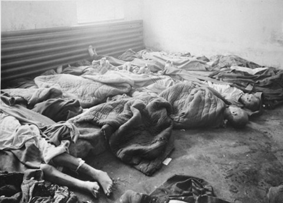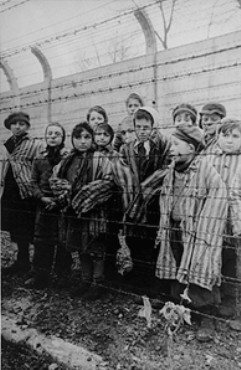Auschwitz-Birkenau - "The Death Factory"

The main entrance of Birkenau (1945)

The main entrance of Birkenau (1945)
The Auschwitz complex was divided in three major camps: Auschwitz I main camp or Stammlager; Auschwitz II, or Birkenau, established on October 8th, 1941 as a 'Vernichtungslager' (extermination camp); Auschwitz III or Monowitz, established on May 31th, 1942 as an 'Arbeitslager' or work camp; also several sub-camps. There were up to seven gas chambers using Zyklon-B poison gas and three crematoria. Auschwitz II included a camp for new arrivals and those to be sent on to labor elsewhere; a Gypsy camp; a family camp; a camp for holding and sorting plundered goods and a women's camp. Auschwitz III provided slave labor for a major industrial plant run by I G Farben for producing synthetic rubber (see Blechhammer). Highest number of inmates, including sub-camps: 155,000. The estimated number of deaths: 2.1 to 2.5 million killed in gas chambers, of whom about 2 million were Jews, and Poles, Gypsies and Soviet POWs. About 330,000 deaths from other causes.
In April 1940, Rudolph Höss, who become the first commandant, identified the Silesian town of Oswiecim as a possible site for a concentration camp. The function of the camp was initially to intimidate Poles and prevent resistance to German rule. It was also perceived as a cornerstone of the policy to re-colonize Upper Silesia, which had once been a German region, with 'pure Aryans'. On April 27th, Himmler ordered construction of the camp.
In May 1940, Poles were evicted from the vicinity of the barracks (most of them were executed), and a work crew comprising concentration camp prisoners was sent from Sachsenhausen. 300 Jews from the large Jewish community of Oswiecim were also pressed into service.
The first transport of prisoners, almost all Polish civilians, arrived in June 1940 and the SS administration and staff was established. On March 1th, 1941, the camp population was 10,900. The camp quickly developed a reputation for torture and mass shootings.
Himmler visited Auschwitz in March 1941 and commanded its enlargement to hold 30,000 prisoners. Himmler also ordered the construction of a second camp for 100,000 inmates on the site of the village of Brzezinka (Birkenau), roughly 4 km from the main camp. This massive camp was intended to be filled with captured Russian POWs who would provide the slave labor to build the SS 'utopia' in Upper Silesia. The chemical giant I G Farben expressed an interest in utilizing this labor force, too. Extensive construction work began in October 1941, under terrible conditions and with massive loss of life. About 10,000 Russian POWs died in the process.

The Death Factory... (1945)
The main camp population grew from 18,000 in December 1942 to 30,000 in March 1943. In July or August 1941, Himmler briefed Höss about the 'Final Solution'. On September 3th, 1941, Soviet POWs at the Auschwitz main camp were used in trials of the poison gas Zyklon-B. This poison gas was produced by the German company "Degesch" (Deutsche Gesellschaft zur Schädlingsbekämpfung). The were gassed in underground cells in Block 11. After this trial, a gas chamber was rigged-up just outside the main camp and in February 1942, two temporary gas chambers opened at Birkenau. The crematories were built by the German company "Topf & son" located at Erfurt.
In March 1942, a women's camp is established at Auschwitz with 6,000 inmates. In August 1942, it was moved to Birkenau. By January 1944, 27,000 women were living in Birkenau, in section B1a, in separated quarters.
In February 1943, a section for Gypsies was established at Birkenau, camp BIIe, and in September 1943 an area was reserved for Czech Jews deported from Theresienstadt, the so-called 'Family Camp', BIIb. The gas chambers and crematoria opened in March 1943.
In Autumn 1943, the camp administration was reorganized following a corruption scandal. By the end of 1943, the prisoner population of Auschwitz main camp, Birkenau, Monowitz and other sub-camps was over 80,000: 18,437 in the main camp, 49,114 in Birkenau, and 13,288 at Monowitz where I G Farben had its synthetic rubber plant. Up to 50,000 prisoners were scattered around 51 sub-camps such as Rajsko, an experimental agricultural station, and Gleiwitz, a coal mine (see The List of the Camps for a complete list of those sub-camps).
The situation in the sub-camps was often even worse than in the main camps. In mid-1944, Auschwitz was designated a huge SS -run security area in Upper Silesia of over 40 sq. The camp population reached in August 1944 105,168. The last roll-call on January 18th, 1945 showed 64,000 inmates.
During its history, the prison population of Auschwitz changed composition significantly. At first, its inmates were almost entirely Polish. From April 1940 to March 1942, on about 27,000 inmates, 30 percent were Poles and 57 percent were Jews. From March 1942 to March 1943 of 162,000 inmates, 60 percent were Jews.
Auschwitz became a significant source of slave labor locally and functioned as an international clearing house. Of 2.5 million people who were deported to Auschwitz, 405,000 were given prisoner status and serial numbers. Of these, approximately 50 percent were Jews and 50 percent were Poles and other nationalities. Of those who received numbers, 65,000 survived. It is estimated that about 200,000 people passed through the Auschwitz camps and survived.
Those deported to Auschwitz arrived at the nearby train station and were marched or trucked to the main camp where they were registered, tattooed, undressed, deloused, had their body hair shaven off, showered while their clothes were disinfected with Zyklon-B gas, and entered the camp under the infamous gateway inscribed 'Arbeit Macht Frei' ("Labor make you free")
A parallel system operated later at Birkenau in 1942-43, except that for the majority the 'showers' proved to be gas chambers. Only about 10 percent of Jewish transports were registered, disinfected, shaven and showered in the 'central sauna' before being assigned barracks. In May 1944, a spur line was built right into the camp to accelerate and simplify the handling of the tens of thousands of Hungarian and other Jews deported in the spring and summer of 1944.
The history of Auschwitz-Birkenau as an extermination center is complex. From late 1941 to October 1942, the mortuary at Auschwitz main camp, which was already equipped with a crematorium, was adapted as a gas chamber. It measured approximately 835 square feet. In the spring of 1942, two provisional gas chambers at Birkenau were constructed out of peasant huts, known as the 'bunkers'.
The first 'bunker', with two sealed rooms, operated from January 1942 to the end of that year. The second, with four air tight rooms, became redundant in the spring of 1943, but remained standing and was used again in the autumn of 1944 when extra 'capacity' was needed for the murder of Hungarian Jews and the liquidation of the ghettos. The second measured about 1.134 square feet. The victims murdered in the 'bunkers' were first obliged to undress in temporary wooden barracks erected nearby. Their bodies were taken out of the gas chambers and pushed to pits where they were burned in the open. Between January 1942 and March 1943, 175,000 Jews were gassed to death here, of whom 105,000 were killed from January to March 1943.

Entrance of a gas chamber in Auscwitz. (1945)
Up to this point, Auschwitz accounted for only 11 percent of the victims of the 'Final Solution'. However, in August 1942, planning began for the construction of four large-scale gassing facilities. It appears from the plans that the first two gas chambers were adapted from mortuaries which, with the huge crematoria attached to them, were initially intended to cope with mortalities amongst the slave labor force in the camp, now approaching 100,000 and subject to a horrifying death rate. But from the autumn of 1942, it seems clear that the SS planners and civilian contractors were intending to build a mass-murder plant.
The twin pairs of gas chambers were numbered II and III, and IV and V. The first opened on March 31, 1943, the last on April 4, 1943. The total area of the gas chambers was 2,255 square meters; the capacity of these crematoria was 4,420 people. Those selected to die were undressed in the undressing room and then pushed into the gas chambers. It took about 20 minutes for all the people to death. In II and III, the killings took place in underground rooms, and the corpses were carried to the five ovens by an electrically operated lift. Before cremation gold teeth and any other valuables, such as rings, were removed from the corpses. In IV and V the gas chambers and ovens were on the same level, but the ovens were so poorly built and the usage was so great that they repeatedly malfunctioned and had to be abandoned. The corpses were finally burned outside, in the open, as in 1943. Jewish sonderkommandos worked the crematoria under SS supervision.
Initially the new facilities were "underutilized". From April 1943 to March 1944, "only" 160,000 Jews were killed at Birkenau, but from March 1944 to November 1944, when all the other death camps had been abandoned, Birkenau surpassed all previous records for mass killing. The Hungarian deportations and the liquidation of the remaining Polish ghettos, such as Lodz, resulted in the gassing of 585,000 Jews. This period made Auschwitz-Birkenau into the most notorious killing site of all time.
In October 1944, the 'Sonderkommando' crew crematoria IV revolted and destroyed the crematories. In November Himmler ordered gassings to stop, and a 'cleanup' operation was inaugurated to conceal traces of the mass murder. In January 1945, the Germans evacuated 58,000 prisoners who could walk. They left behind in the main camp, Birkenau and in Monowitz about 7,000 sick or incapacitated who they did not expect would live for long.
When Soviet troops liberated Auschwitz on January 27, 1945, they found these pitiful survivors as well as 836,525 items of women clothing, 348,820 items of men clothing, 43,525 pairs of shoes and vast numbers of toothbrushes, glasses and other personal effects. They found also 460 artificial limbs and seven tons of human hair shaved from Jews before they were murdered. The human hairs were used by the company "Alex Zink" (located in Bavaria) for confection of cloth. This company was paying the human hairs 50 pfennig/kilo.

What remained from the victims: tons of clothes and shoes... (1945)
Remarkably, there were instances of individual resistance and collective efforts at fighting back inside Auschwitz. Poles, Communists and other national groups established networks in the main camp. A few Jews escaped from Birkenau, and there were recorded assaults on Nazi guards even at the entrance to the gas chambers. The 'Sonderkommando' revolt in October 1944 was the extraordinary example of physical resistance.

The children of Auschwitz at the liberation of the camp (1945)